Recent demonstrations of magnetotransport effects in antiferromagnets (AFMs) make them attractive candidates for usage as active elements in future spintronic devices [1].
We investigated the magnetic properties of antiferromagnetic NiO(001) thin films in epitaxially grown (Fe)/NiO/MgO(dMgO)/Cr/MgO(001) system for different thicknesses of MgO, dMgO. Figure 1 shows exemplary room temperature x-ray absorption spectra acquired with linear polarization of the photon beam, recorded at the Ni2+ L2 edge in the NiO/MgO(18 Å)/Cr. The results of systematic XMLD measurements show that with increasing dMgO, the rotation of NiO spins from in plane towards out of plane direction occurs. The analysis of the XMLD results together with the analysis of low-energy electron diffraction (LEED) pattern, brought us to the conclusion that for NiO layer grown on a wedge-shaped MgO underlayer, the magnetic anisotropy in NiO can be modulated by exerting appropriate strain from its bottom interface.
While strain allows tuning magnetic anisotropy of the AFM from its bottom interface, interaction with the ferromagnetic cover layer enables to influence the magnetic state of the AFM from its top interface. The interfacial exchange coupling between Fe and NiO spins in Fe/NiO/MgO(dMgO)/Cr/MgO(001) was directly confirmed by XMLD- and XMCD- Photoemission Electron Microscope (PEEM) measurements (Fig. 2). The competition between exchange coupling to the ferromagnet and the strain-induced anisotropy creates a multiple domain structure in the NiO thin film.
1.Jungfleisch, M. B., Zhang, W. & Hoffmann, A. Perspectives of antiferromagnetic spintronics. Phys. Lett. A 382, 865–871 (2018).
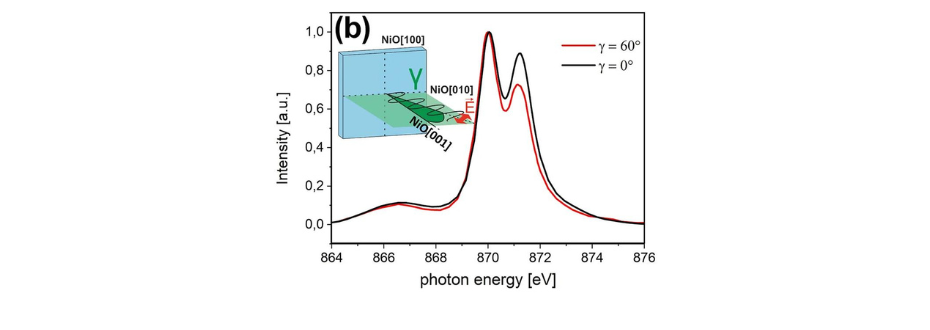
Figure 1. Exemplary Ni2+ L2-edge x-ray absorption spectra at γ = 0° (black line) and γ = 60° (red line) obtained at room temperature for NiO/MgO(18.3 Å)/Cr/MgO(001). The scheme in the inset shows the geometry of the XMLD experiment. (Source: Sci. Rep. 13, 4824 (2023))
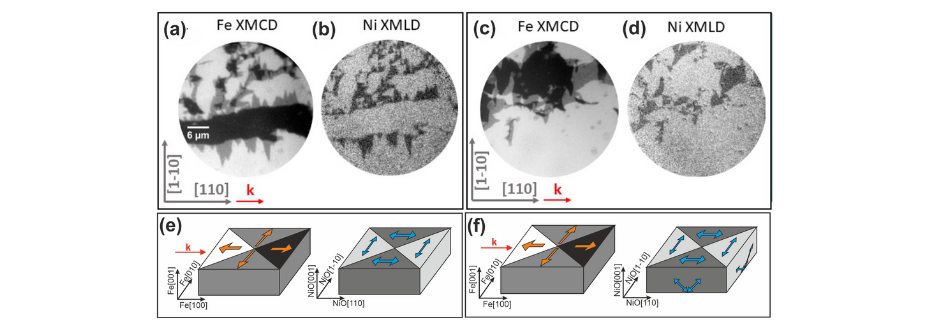
Figure 2. (a, c) The Fe L3 XMCD-PEEM images obtained for Fe/NiO/MgO(10 Å)/Cr and Fe/NiO/ MgO(200 Å)/Cr, respectively. (b) and (d) corresponding Ni L2 XMLD-PEEM images acquired with vertical polarization. (e) and (f) a schematical illustration of spin structure with directions of magnetic moments indicated by the arrows for Fe/NiO/MgO(10 Å)/Cr and Fe/NiO/MgO(200 Å)/Cr, respectively. (Source: Sci. Rep. 13, 4824 (2023)).
Written by: Weronika Janus
The publication can be found here:
W. Janus et al., Tunable Magnetic Anisotropy of Antiferromagnetic NiO in (Fe)/NiO/MgO/Cr/MgO(001) Epitaxial Multilayers, Sci Rep 13, 4824 (2023). doi:10.1038/s41598-023-31930-z
Lithium cell technologies are currently the most dynamically developing area related to the storage and processing of electricity for the needs of portable electronics, electric cars and energy storage from renewable sources. The working mechanism of Li-ion cells is based on a reversible reaction of introducing a significant amount of lithium ions together with an equivalent amount of electrons into the structure of a transition metal compound MaXb (M - transition metal, X= O,S): xLi+ + xe- + MaXb ↔ LixMaXb.
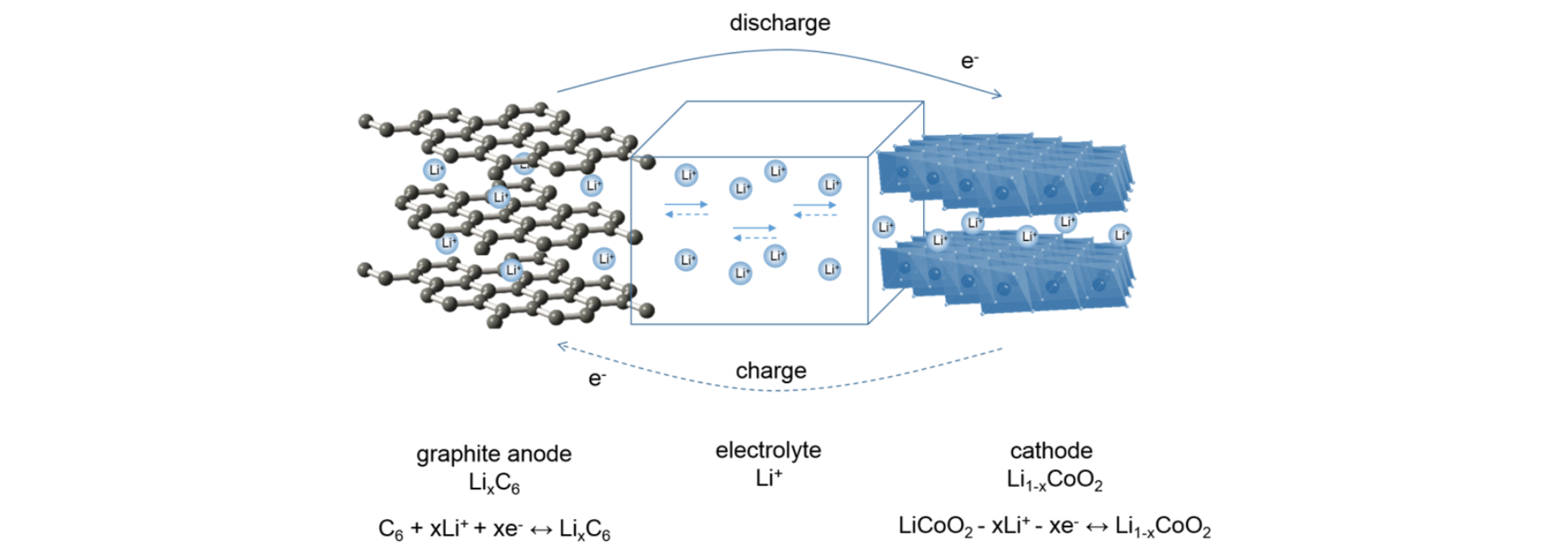
Fig.1. The work scheme of the Li-ion cell.
This process, called the intercalation process, takes place at room temperature without destroying the structure of the material, even for several thousand cycles of lithium intercalation/deintercalation. The Na-ion cells show the same working mechanism. Indispensable for the process effectiveness is high conductivity of lithium (sodium) ions and electrons in the base material. Layered transition metal oxides used as electrode materials in commercial cells (LiCoO2) are characterized by instability of the crystal structure at lower alkali content, which leads to the limitation of their practical capacity to 50% of the theoretical capacity. This problem also occurs in sodium electrode materials. The starting point for improving the structural stability of layered transition metal oxides was the concept of high-entropy configuration, which can be achieved by introducing several different transition metal cations randomly distributed in one position of the transition metal in the crystal structure of the oxide. The increase in configurational entropy in the proposed high-entropy oxide with the composition NaMn0.2Fe0.2Co0.2Ni0.2Ti0.2O2 contributes to lowering system energy, which led to an increase in its chemical stability, increase in the density of stored energy and improved safety of battery use. Comprehensive studies, both experimental and theoretical, have shown a strong correlation between the structural, transport and electrochemical properties of this oxide. The modification of the crystalline structure occurring in the course of sodium deintercalation leads to metallic conductivity and better kinetics of the NaxMn0.2Fe0.2Co0.2Ni0.2Ti0.2O2 electrode material, which has a high capacity of 180 mAh·g-1, much higher than the commercial LiCoO2 material, which can lead to the development of sodium battery technology, especially for large-scale energy storage.
The publication can be found here:
In our studies we investigated the influence of the proximity of the antiferromagnetic CoO layer on the magnetic properties of ultrathin wüstite (FeO) films. Comparative Mössbauer spectroscopy measurements for MgO/FeO/MgO(001) and MgO/FeO/CoO/MgO(001) show that the neighboring CoO layer can significantly enhance the ordering temperature (TN) of wüstite. The TN of CoO in the FeO/CoO bilayer was determined with a use of X-ray magnetic linear dichroism (XMLD) measurements.
Antiferromagnets (AFMs) due to their unique properties are promising candidates for the next generation spintronic materials [1], [2]. A wide group of AFM materials seems to be useless for applications due to the low ordering temperature, above which the long-range antiferromagnetic order vanishes. The limitation of low TN can be overcome using the magnetic proximity effect [3]. In our study we proved that the proximity of CoO strongly influences the magnetic properties of the FeO layer. For the FeO layers grown on 2 nm-thick CoO, the ordering temperature of FeO was increased by 100 K due to the magnetic proximity. This result shows that the limitation of the low ordering temperature of wüstite can be overcome by the antiferromagnetic proximity. To determine the TN of CoO in the FeO/CoO bilayer, we performed X-ray magnetic linear dichroism (XMLD) measurements. X-ray absorption spectra (XAS) were collected at the PIRX beamline of the National Synchrotron Radiation Centre SOLARIS. Figure 1 shows exemplary normalized XAS spectra for a CoO thickness of 2 nm in FeO/CoO, collected under normal and 60o X-ray incidence angles at 80 K. Systematic studies of CoO XAS spectra as a function of temperature enabled us to determine the TN of CoO in FeO/CoO bilayer.
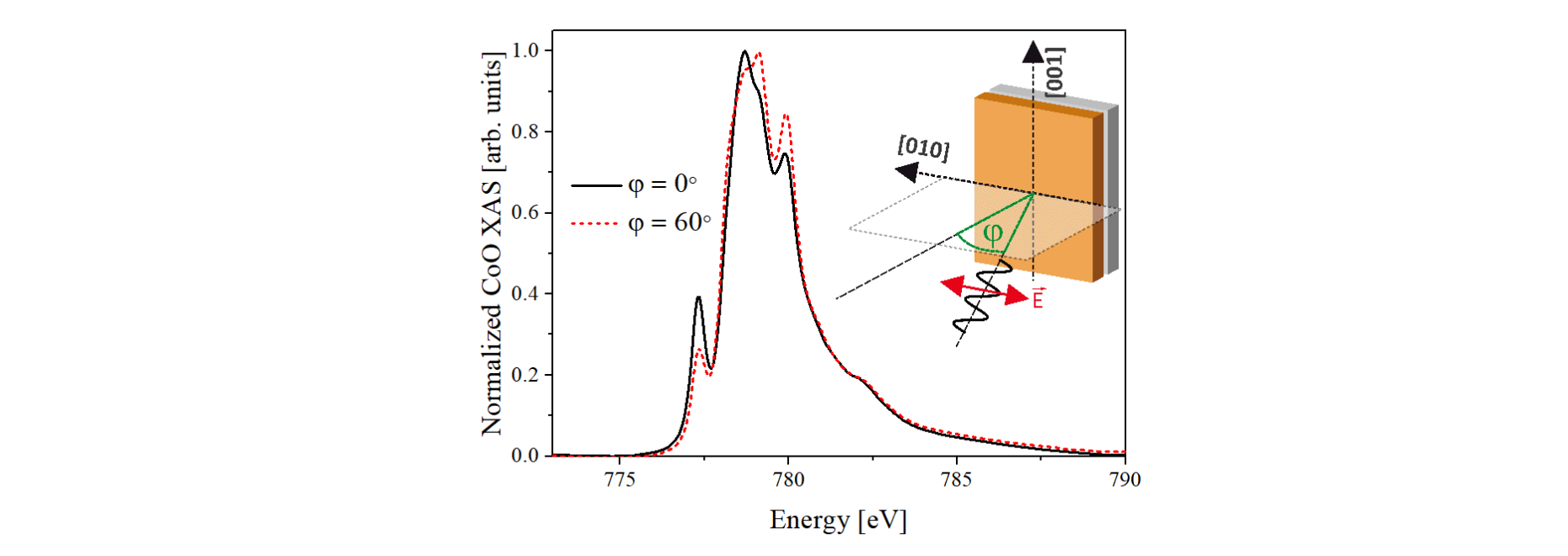
Fig. 1. Co L3 edge XAS spectra at φ = 0° (black solid line) and φ = 60° (red dashed line) obtained for FeO/CoO at 80 K. Inset shows the measurement geometry. (source: Appl. Phys. Lett. 120, 072404 (2022))
[1] V. Baltz, A. Manchon, M. Tsoi, T. Moriyama, T. Ono, and Y. Tserkovnyak, Antiferromagnetic Spintronics, Rev Mod Phys 90, 15005 (2018).
[2] P. K. Manna and S. M. Yusuf, Two Interface Effects: Exchange Bias and Magnetic Proximity, Phys Rep 535, 61 (2014).
[3] D. Hou, Z. Qiu, and E. Saitoh, Spin Transport in Antiferromagnetic Insulators: Progress and Challenges, NPG Asia Mater 11, 35 (2019).
The publication can be found here:
Virgin and Yb-implanted epitaxial ZnO films were investigated by XANES. This study revealed a strong polarization dependence of films determined by the orientation of the polarization vector of the synchrotron radiation to the sample surface. It also indicated that the implantation and subsequent annealing have an important influence on the native point defect complexes in the ZnO. The analysis of the obtained data suggests that the donor-acceptor complexes are present both in as grown and implanted films and may influence their electrical properties. This suggestion was confirmed by previous Hall measurements showing that the resistivity of annealed ZnO:Yb film with a fluence of 5e15 ions/cm2 decreases by about one order compared to the one with a fluence of 5e14 ions/cm2.
Usage of ZnO doped by Yb, in optical and optoelectronic applications is not possible without better understanding of how presence of defects and/or their agglomerates alters the electronic structure, and chemical and physical properties of these materials. In this work, we studied virgin and Yb-implanted epitaxial ZnO films employing X-ray absorption technique (such as polarization- dependent XANES) available at the PIRX (former PEEM/XAS) beamline at National Synchrotron Radiation Centre SOLARIS. Analysis of experimental spectra (together with theoretical simulations, confirmed the presence of donor-acceptor complexes (mVZn - nVO, m = 1,4; n = 1,2) in the samples under study, see Figure 1. It was also concluded that oxidation state of Yb in ZnO is 3+, and that Yb are surrounded by oxygen in pseudo octahedra. This is consistent with the XPS findings and previously conducted RPES investigations. Different doses of implantation disturb the orientation of these octahedra with respect to the growth of direction of film that was observed from an inversion of the polarization dependence for samples with different Yb fluences. Ultimately, our study aims to deepen understanding of implantation-induced defects, their interaction with host matrix defects, and efforts to eliminate, manipulate and/or reorganize these defects via annealing to achieve good quality material useful for optoelectronic applications.
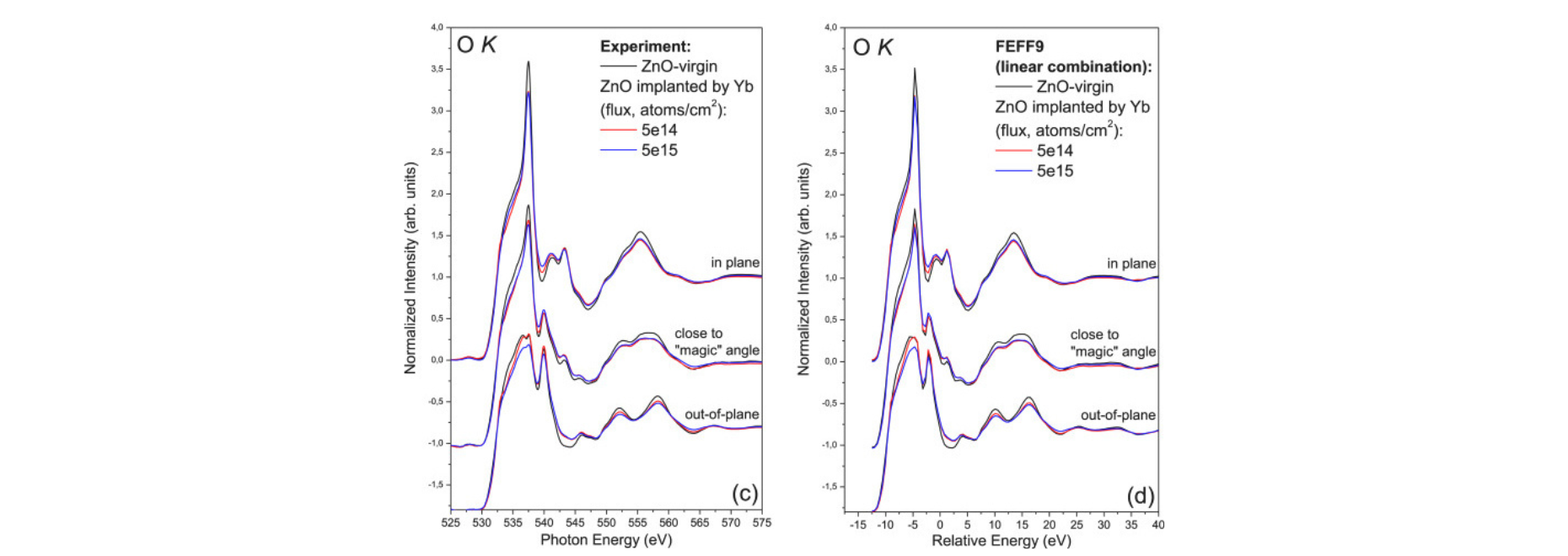
Figure 1. (c) Comparison of O K-edge XANES spectra of a reference ZnO film and of ZnO:Yb films with different doses of Yb (5e14 and 5e15 atoms/cm2). All samples are after a Rapid Thermal Annealing. (d) O K-edge XANES spectra obtained by linear combination of selected theoretical models calculated by FEFF code for different polarization geometry.
The publication can be found here:

